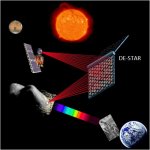An incident in Russia on Friday where a 17 metre diameter meteor burning up in the atmosphere created chaos, millions of dollars in damage and injured over a thousand people was a tap on the shoulder as to how destructive bits falling from the sky can be.
According to NASA, revised estimates for the energy released during the event have been pegged at nearly 500 kilotons.
A “near miss” (~28,000 kilometres) also occurred on Friday. Known as 2012 DA14, that asteroid has a diameter of 50 metres and a mass estimated similar to the meteoroid that caused the 1908 Tunguska Event. That event, which was also in Russia, destroyed an estimated 80 million trees over an area covering 2,150 square kilometres.
It’s thought a 10km diameter meteorite that slammed into Mexico 66 million years ago was a contributing factor in the extinction of the dinosaurs.
So what’s a species with opposable thumbs and rather large brain capacity to do to thwart such events?
Enter the DE-STAR (yes Star Wars fans, we know).
Boffins at the University of California – Santa Barbara and California Polytechnic State University have proposed the DE-STAR, or Directed Energy Solar Targeting of Asteroids an exploRation, as a way of dealing with potential threats posed to the Earth by asteroids and comets.
Unlike Star Wars’ Death Star’s attack on Alderaan that saw an entire planet blown to smithereens in seconds, the DE-STAR would chip away at pesky asteroids over a period of time. Depending on the scenario, the goal might not be to turn these bodies into harmless tiny chunks, but change their surface just enough to alter their path.
“This system is not some far-out idea from Star Trek,” says Gary B. Hughes, a researcher and professor from California Polytechnic State University, San Luis Obispo. “All the components of this system pretty much exist today. Maybe not quite at the scale that we’d need –– scaling up would be the challenge –– but the basic elements are all there and ready to go.”
DE-STAR isn’t the only concept involving solar power and lasers to fend off asteroids. Last year we reported on engineers at the University of Strathclyde in Glasgow also working on a somewhat similar asteroid deflection system.
Source/image source







































